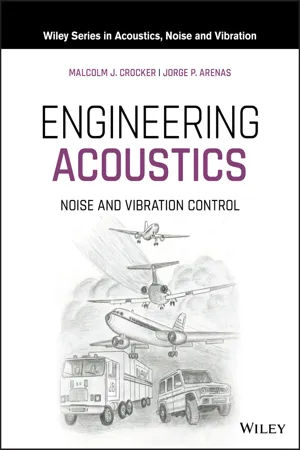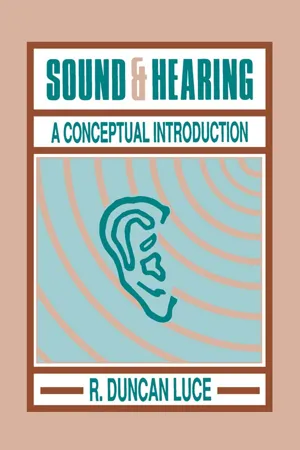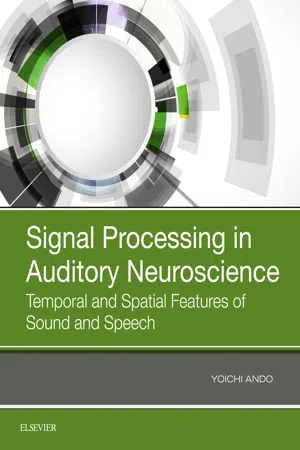Physics
Structure of the Ear
The structure of the ear consists of three main parts: the outer ear, middle ear, and inner ear. Sound waves enter the outer ear and travel through the ear canal to the eardrum, causing it to vibrate. These vibrations are then transmitted through the middle ear bones to the cochlea in the inner ear, where they are converted into electrical signals and sent to the brain.
Written by Perlego with AI-assistance
Related key terms
11 Key excerpts on "Structure of the Ear"
- eBook - ePub
Communication Acoustics
An Introduction to Speech, Audio and Psychoacoustics
- Ville Pulkki, Matti Karjalainen(Authors)
- 2015(Publication Date)
- Wiley(Publisher)
anatomical structure of hearing is also somewhat interesting, though not very important as such, except in some special cases, such as audiology or spatial hearing. Thus, a brief introduction to both the anatomy and physiology of the auditory system is considered sufficient in this chapter.7.1 Global Structure of the Ear
Humans, as well as most animals, have two sensors for sound – the left and right ear – and a complex neural system to analyse the sound signals received by them. The ear, more specifically the peripheral auditory system, consists of the external ear for capturing sound waves travelling in the air, the middle ear for mechanical conduction of the vibrations, and the inner ear for mechanical-to-neural transduction. Neural signals from the periphery are transmitted through the auditory pathway, where the neural signals are processed by different nuclei up to the auditory cortex where high-level analysis occurs.Figure 7.1 depicts a cross-section of one ear, including the external (outer), the middle ear, and part of the inner ear. Figure 7.2 shows a more schematic diagram characterizing the most essential parts of the system and the path from acoustic wave to neural signal.Cross-sectional diagram of one ear, showing the external, middle, and inner ear.Figure 7.1A simplified diagram of the ear.Figure 7.27.2 External Ear
The external ear (outer ear) consists of the pinna with the concha, the ear canal or meatus, and the eardrum or tympanic membrane as a borderline with the middle ear (Figure 7.1 ). The external ear is passive and linear, and its functioning is entirely based on the laws of acousticPhysiology and Anatomy of Hearing wave propagation. Passivity means that the external ear does not generate sound energy or ‘react’ to the sound, it only carries sound waves properly to the eardrum and the middle ear.Acoustically, the entire head (and shoulders) makes part of the external ear. The distance between the two ears, located at opposite sides of the head, causes an arrival time difference of the sound wavefront that depends on the angle of incidence. A difference in sound level appears at high frequencies due to shadowing by the head to the side that is opposite to the sound source. These phenomena and related effects in spatial hearing are discussed in Chapter 12 . In the present chapter, we concentrate on monaural - eBook - ePub
Engineering Acoustics
Noise and Vibration Control
- Malcolm J. Crocker, Jorge P. Arenas(Authors)
- 2020(Publication Date)
- Wiley(Publisher)
4 Human Hearing, Speech and Psychoacoustics4.1 Introduction
The human ear is a marvelous and very sensitive biomechanical system for detecting sound. If it were only slightly more sensitive, we would be able to hear the Brownian (random) motion of the air molecules and we would have a perpetual buzz in our ears! The ear has a wide frequency response from about 15 or 20 Hz to about 20 kHz. Also, the ear has a large dynamic range; the ratio of the loudest sound pressure we can tolerate to the faintest we can hear is about 10 million (107 ). There are three essential reasons to consider the ear in this book. Sound pressure levels are now so high in industrialized societies that many individuals are exposed to intense noise and permanent damage results. Large numbers of other individuals are exposed to noise from aircraft, surface traffic, construction equipment or machines and appliances, and disturbance and annoyance results. Lastly there are subjective reasons. An understanding of people's subjective response to noise allows environmentalists and engineers to reduce noise in more effective ways. The human auditory response to sound concerns the science called psychoacoustics. For example, noise should be reduced in the frequency range in which the ear is most sensitive. Noise reduction should be by a magnitude which is subjectively significant. There are several other subjective parameters which are important in hearing.4.2 Construction of Ear and Its Working
The ear can be divided into three main parts (Figure 4.1 ): the outer, middle, and inner ear. The outer ear consisting of the fleshy pinna and ear canal conducts the sound waves onto the eardrum. The middle ear converts the sound waves into mechanical motion of the auditory ossicles, and the inner ear converts the mechanical motion into neural impulses which travel along the auditory nerves to the brain. The anatomy and functioning of the ear are described more completely in various other references and textbooks [1 –8 - eBook - ePub
- Wendy Holmes(Author)
- 2002(Publication Date)
- CRC Press(Publisher)
CHAPTER 3Mechanisms and Models of the Human Auditory System
3.1 INTRODUCTIONWhen considering the requirements for speech synthesis, or methods for automatic speech recognition, much insight can be gained from knowledge about the workings of the human auditory system. Unfortunately, because of the invasive nature of most physiological studies and the large number and extremely small size of the neurons involved, study in this area has been extremely difficult, and our knowledge is very incomplete. Even so, over the recent decades much progress has been made, with a combination of psychophysical studies on humans, neurophysiological studies on experimental animals, and computer modelling to investigate plausible hypotheses.3.2 PHYSIOLOGY OF THE OUTER AND MIDDLE EARSFigure 3.1 illustrates the structure of the human ear. The outer ear consists of the pinna, which is the visible Structure of the Ear, and the passage known as the auditory canal. Sound impinging on the side of the head travels down the auditory canal to reach the eardrum, or tympanic membrane. However, the pinna plays a significant role because the effect of reflections from the structures of the pinna is to introduce spectral changes at high frequencies, which can be used to judge the direction of a sound source. The effect is confined to frequencies above 3 kHz or so, as it is only at these high frequencies that the wavelength of the sound is short enough for it to interact with the structures of the pinna.The length of the auditory canal is such that it forms an acoustic resonator, with a rather heavily damped main resonance at about 3.5 kHz, and some slight secondary resonances at higher frequencies. The principal effect of this resonant behaviour is to increase the ear’s sensitivity to sounds in the 3–4 kHz range. - Benjamin Wardhaugh(Author)
- 2017(Publication Date)
- Routledge(Publisher)
3 Here, I will discuss a selection of sixteenth- and seventeenth-century anatomical writings about the ear, including those written in England.The Modern Ear
In the twenty-first century, our understanding of the function of the ear is still incomplete as far as it concerns the details of the actual conversion of physical vibrations into nerve impulses, and particularly the limitations and idiosyncrasies of that conversion. the earlier stages of the transmission of vibrations through the ear, though, are now well understood, and it is worth taking the time to describe the structure and function of the ear in sufficient detail to understand the historical discussions of them which follow: the reader’s patience is craved for what is inevitably a somewhat dense discussion. throughout it, I will use modern terms as far as possible, and refer to Figure 3.1 .4Figure 3.1 The human ear. Illustration by J. Wardhaugh.The ear is usually divided into three distinct but contiguous structures: the outer, middle and inner ear. the outer ear, that part which stands outside the head and is commonly referred to as ‘the ear’, is of little interest to us, although it does have two identifiable auditory functions: it amplifies sounds by channelling them down a funnel like an ear-trumpet, and it introduces subtle patterns of echo and delay which help in determining the location of a sound’s source.The middle ear consists of the (external) auditory meatus (The ear canal), and the tympanic cavity with its contents. the former is a narrow tube of cartilage and bone, lined with skin: although not straight, its detailed shape is not now considered to have the amplifying function which some early anatomists assigned to it. at the inner end of the auditory meatus lies the tympanic membrane (The eardrum), which is attached to the tympanic element of the temporal bone (The upper part of the skull) and consists of an outer layer of skin continuous with the skin of the auditory meatus, an inner layer continuous with that of the tympanic cavity, and a distinct middle layer.5- eBook - ePub
Physics And Biology: From Molecules To Life
From Molecules to Life
- Jean Franᅢᄃois Allemand, Pierre Desbiolles(Authors)
- 2014(Publication Date)
- WSPC(Publisher)
μPa and elicit vibrations of the tympanic membrane of less than one picometer. This amplitude is comparable to that of the Brownian movement that shakes our ears even in the absence of any sound stimulus! The ear thus operates at a physical limit imposed by its own thermal fluctuations. Interestingly, the ear is less sensitive to sounds that last less than about 200ms; longer sounds are easier to detect. In 1948, the physicist Thomas Gold recognized in this property the signature of a mechanical resonance. By accumulating mechanical energy from cycle to cycle, the amplitude of sound-evoked vibrations would grow until the threshold of detection is reached. By modeling the ear as a harmonic oscillator (a mass attached to a spring and subjected to viscous drag), Gold observed that the ear operates as a high-quality resonator, as if vibrations inside the cochlea were very lightly damped by the surrounding fluid. However, the vibrating structures are immersed in a fluid too viscous to allow for passive resonance. To alleviate this apparent contradiction, Gold was the first to argue that the ear must be endowed with an active process of amplification that reduces friction on the inner ear. This conclusion was largely ignored at the time and it took thirty years before the existence of the “cochlear amplifier” was finally accepted.Figure 7.1. The human ear. Sound pressure waves first set the middle ear into mechanical vibrations. The middle ear is composed of the tympanic membrane (also called the eardrum) across the ear canal, and of a chain of three ossicles (incus, malleus, stapes). This arrangement affords efficient transmission of the acoustic energy that propagates through the air to sensory structures that are immersed in physiological fluid in the auditory organ — the cochlea. The ear also mediates the sense of balance by using the vestibular system to detect head accelerations. In particular, the semi-circular canals respond to head rotations. Adapted from (http://fr.wikipedia.org/wiki/Oreille ).The ear is also remarkable because it can respond to sounds with frequencies that vary over three orders of magnitude, typically from 20Hz to 20 kHz in human hearing. Other mammals, like whales and bats can even hear sounds up to 100 kHz. These frequencies imply that mechano-electrical transduction must be fast enough to follow temporal variations of the acoustic pressure over timescales as short as a few tens of microseconds. In addition, the ear can discriminate sounds with sharp frequency selectivity. A trained musician can indeed hear the difference between two sounds, when they are played one after the other, that differ by only 0.2%, corresponding to a couple of hertz for frequencies near one kilohertz. - eBook - ePub
Phonetics
Transcription, Production, Acoustics, and Perception
- Henning Reetz, Allard Jongman(Authors)
- 2011(Publication Date)
- Wiley-Blackwell(Publisher)
The observation that a given phoneme can be produced with different articulatory gestures suggests that, in addition to an articulatory description, auditory and perceptual descriptions of speech sounds are important as well. For example, vowels are produced with rather different tongue positions by individual speakers, and the production of “rounded” vowels (like [u]) does not necessarily require a lip gesture after all: just stand in front of a mirror and try to produce an [u] without pursing the lips. This suggests that auditory targets (for example, the distribution of energy in a spectrum) rather than articulatory targets (like the position of the tongue) play the major role in speech perception. In other words, although it is possible to describe speech sounds in articulatory terms, and although the existing articulatory categorizations are generally quite effective, it may be advantageous to use auditory or perceptual categories.The following sections describe basic knowledge about the ear and the hearing process. The hearing organ is composed of a series of structures: the external ear, middle ear, and internal ear. The internal ear contains relatively simple sensory cells, which are surrounded by a watery liquid. The neural impulses registered by the sensory cells are then analyzed by the brain.12.1 The External Ear
What is called the “ear” in everyday language is only a small part of the actual hearing organ. As represented in Figure 12.1 , the external ear consists of the visible auricle (pinna), the meatus (ear canal), and the tympanic membrane (ear drum).Figure 12.1 External, middle, and internal ear and their main structures.The auricle helps humans to determine the origin of a sound, in particular, whether it comes from in front of or behind the head. The presence of this information can be easily demonstrated by putting on headphones. Since headphones disable the localization function of the auricles, no information is available about the location of the sound source in relation to the head. The music therefore sounds as if it comes from somewhere “inside the head.”After passing the auricle, the sound wave arrives in the ear canal (meatus). This channel is covered on the inside with a thin layer of earwax (cerumen), a noxious and sticky substance to prevent the ear canal from drying out and to keep insects out. If the ear canal is blocked, for example, by earwax, hearing capacity is considerably reduced. - eBook - ePub
Functional and Clinical Neuroanatomy
A Guide for Health Care Professionals
- Jahangir Moini, Pirouz Piran(Authors)
- 2020(Publication Date)
- Academic Press(Publisher)
Chapter 12Auditory system
Abstract
The human ear has various sensory functions. It not only is used for hearing, but also for balance or equilibrium . For hearing and balance, the stimulation needed involves activation of hair cells , which are mechanoreceptors. Upon the hair cells, sound waves and fluid movement act to generate receptor potentials. After this, nerve impulses are generated that are soon perceived in the brain as either sound or balance. The eighth cranial nerve consists of the cochlear nerve , used for hearing and vestibular nerve , used for balance. There are three anatomical parts of the ear: the external ear, the middle ear, and the inner ear.Keywords
Ampulla; Auricle; Basilar membrane; Pillar cells; Saccule; UtricleThe human ear has various sensory functions. It not only is used for hearing, but also for balance or equilibrium . For hearing and balance, the stimulation needed involves activation of hair cells , which are mechanoreceptors. Upon the hair cells, sound waves and fluid movement act to generate receptor potentials. After this, nerve impulses are generated that are soon perceived in the brain as either sound or balance. The eighth cranial nerve consists of the cochlear nerve , used for hearing and vestibular nerve , used for balance. There are three anatomical parts of the ear: the external ear, the middle ear, and the inner ear.Anatomical structures
The anatomical structures of the human ear include the external, middle, and inner components (Fig. 12.1 ). Note that these structures are not illustrated by their actual sizes, with the middle and inner structures enlarged so that they are more easily seen.Fig. 12.1 The ear. External, middle, and inner ear structures. (Anatomic structures are not drawn to scale. Middle and inner ears enlarged for better visualization here.)(From Patton, K. T.; Thibodeau, G. A. Anatomy & Physiology, 8 ed.; Mosby: St Louis, 2013.)External ear
There are two divisions of the external ear. These include the visible appendage known as the auricle or pinna, and the ear canal, which is also called the external acoustic meatus . The meatus is about 3 cm in length. At its beginning, it slants upward slightly, then curving downward through the temporal bone, in a direction that is both inward and forward. The ear canal ends at the tympanic membrane - eBook - ePub
Sound & Hearing
A Conceptual Introduction
- R. Duncan Luce(Author)
- 2013(Publication Date)
- Psychology Press(Publisher)
PART IIIProperties of the Ear
1. THE OUTER AND MIDDLE EARS
1.1 Structures
The ear is composed of three quite distinct parts called the outer, middle, and inner ears. The only part we can see is the outer ear. See Fig. III. 1 for a cross-section of the entire structure.The outer ear too can be partitioned into three parts:An incoming sound wave is channeled by the pinna and external auditory meatus and, to a degree, modified by them until it reaches the tympanic membrane. At that point the middle ear comes into play.Informal terms: Cup Ear Canal Ear Drum ↕ ↕ ↕ More technical: Pinna External Auditory Meatus Tympanic Membrane The middle ear consists of an air-filled cavity, roughly a sphere, formed by a bony structure (see Fig. III. 1 ). This cavity is connected to the oral cavity by the eustachian tube. Within the cavity are three linked bones called ossicles, which are suspended by means of ligaments attached to the bone forming the cavity. The first ossicle is attached to the tympanic membrane and the third to a membrane called the oval window that interfaces the middle and inner ears. Basically, the ossicles simply link the outer ear to inner ear. (Their roles in hearing become clear later.)The names of the ossicles and their linkage is as follows:FIG. III.1 A schematic cross-section showing the major anatomical components of the ear. From Human Information Processing: An Introduction to Psychology (p. 221) by P. H. Lindsay and D. A. Norman, 1972, New York: Academic Press. Copyright 1972 by New York: Academic Press. Reprinted by permission.Tympanic membrane → malleus (also called the hammer) → incus (also called the anvil) → stapes → oval window The part of the stapes attached to the oval window is called the footplate.In addition to the suspension ligaments, muscles are located in bony tubes that connect both the malleus and the stapes to the wall of the cavity. (These are not shown in the figure.) Their role is to protect the inner ear from sounds that are so loud they can cause damage. We describe that action more fully later (Section III. 1.2 - William O. Reece, Eric W. Rowe(Authors)
- 2017(Publication Date)
- Wiley-Blackwell(Publisher)
The ear has components associated with the special sense of hearing and those involved with positional equilibrium. Sound waves are directed to the receptors for hearing in the inner ear via the external ear and middle ear. The inner ear has the receptors not only for hearing but also for equilibrium.External Ear
The external ear (Figure 5-5) consists of the outer visible part (the pinna ) and ear canal that extends from the pinna into the substance of the skull (external acoustic meatus ) to the middle ear (tympanic cavity). The pinna in most animals consists of a funnel-shaped cartilage that is lined on the outside with skin having a generous amount of hair and on the inside with relatively hairless skin. Varying degrees of muscle attachment lend mobility to the pinna, which is helpful in localizing and picking up sounds. The funnel-shaped cartilage concentrates sound waves and directs them through the ear canal toward the tympanic membrane, which separates the middle ear from the external ear.FIGURE 5-5Transverse section through the dog head. The external ear (pinna and ear canal) provide for transfer of sound waves to the tympanic membrane. The ear canal in the dog has a vertical and an oblique component.Middle Ear
The middle ear and inner ear are shown inFigure 5-6. The middle ear is separated from the inner ear by membranes that close the vestibular (oval) window and cochlear (round) window . The middle ear communicates with the pharynx by way of the auditory tube (often called the eustachian tube). The auditory tube allows for equalization of pressures between an otherwise closed cavity and the outside. Within the middle ear a mechanical linkage is provided between the tympanic membrane and the membrane closing the vestibular window by three auditory ossicles (bones). From lateral to medial they are the malleus , incus , and stapes , or, more commonly, the hammer, anvil, and stirrup. Amplification of sound waves is provided by leverage of the ossicles and by the greater surface area of the tympanic membrane, which transmits sound waves to the smaller surface area of the vestibular window. Excessively loud noises are damped by two skeletal muscles in the middle ear, the tensor tympani and the stapedius muscle (Figure 5-7- eBook - ePub
Signal Processing in Auditory Neuroscience
Temporal and Spatial Features of Sound and Speech
- Yoichi Ando(Author)
- 2018(Publication Date)
- Academic Press(Publisher)
Chapter 2Human Hearing System
Abstract
This chapter describes the sensitivity of the human ear to sound signals as corresponding to the A-weighting network, which is formed primarily by the total transfer function of the external canal, eardrum, bone chain, and the oval window.Keywords
A-weighting network; Physical systemPhysical Systems of the Human Ear
Head, Pinna, and External Auditory Canal
An acoustic signal is perceived by the ears, in which a sound signal is given by a time sequence. The three-dimensional space is also perceived by the two ears. This is due mainly to the head-related transfer functions Hl,r (r/r0 , ω) between a source point and the two ear entrances, which have directional qualities based on the shape of the head and the pinna system. The directional information is contained in such head-related transfer functions, including the interaural time difference and the interaural amplitude difference.Fig. 2.1 shows examples of the amplitude of the head-related transfer function H(ξ,η,ω) as parameters of the vertical angle of incidence η (ξ = 0), ξ being the horizontal angle. These were measured by the single-pulse method in far-field conditions.1 The angle η = 0°, ξ = 0° corresponds to the frontal direction and η = 90° to the upper direction. In this situation, the time difference between two ears is τIACC = 0°, and the only difference is the angular frequency characteristic, ω.Because the diameter of the external canal is small enough compared to the wavelength below 8 kHz, the transfer function of the entrance canal E(ω) is independent of the directions in which sound is incident to the human head for the audio frequency range:El,r( ω )∼ El,r( ξ,η,ω )∼ E( ω )2.1Thus, interaction between the sound field in the external canal and that on the outside, including the pinna, is insignificant. The transfer function from the free field to the eardrum can be obtained by multiplying the following two functions. - eBook - ePub
- Hartmut Zabel(Author)
- 2023(Publication Date)
- De Gruyter(Publisher)
Table 12.3 gives an overview of the properties of IHC and OHC. The mechanoelectric transduction is the auditory working principle in all mammals, never mind how small they are. Even in birds, the basic principle is identical. However, the avian middle ear appears to be somewhat simpler, featuring only one ossicle between tympanic membrane and oval window.Tab. 12.3: Comparison of the physical and biophysical properties of inner and outer hair cells.IHC OHC Main task Sound reception and signal transmission to the auditory cortex Sound amplifier Hair cells One raw Three raws Hair cell organization Straight V-shaped Innervation Afferent Efferent Number of nerve fibers per cell 5–10 1 Prestin density Zero High Motility Passive motility Active electromotility Contact with tectorial membrane None Yes Potential change Graded Graded Response to potential change Ca2+ release Resonant oscillation 12.4.6 Frequency coding
There are about 30 000 afferent nerve fibers; most of these connect to the IHCs, 5–10 fibers to each inner hair cell, shown schematically in Fig. 12.17 . Only a few efferent nerve fibers come from the superior olivary complex and connect to the OHCs one after the other. Their function is currently not well understood. However, it is known that the OHC has predominantly a modulating inhibitory influence on the sensitivity of the IHC. In fact, we not only perceive sound from the outside but we can also generate sound with our vocal cords. It is therefore sensible and necessary that there must be a feedback system between sound generation and sound perception, which most likely has its origin in the efferent connection of the OHC.Fig. 12.17: Connection of afferent and efferent nerve fibers to inner and outer hair cells, respectively. Note that each inner hair cell is connected to many afferent nerve fibers (about 10) required for decoding frequency and intensity (adapted from http://www.open.edu/openlearn
Index pages curate the most relevant extracts from our library of academic textbooks. They’ve been created using an in-house natural language model (NLM), each adding context and meaning to key research topics.










